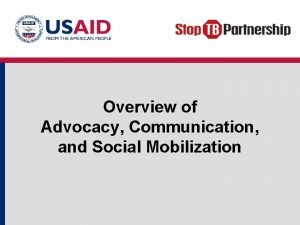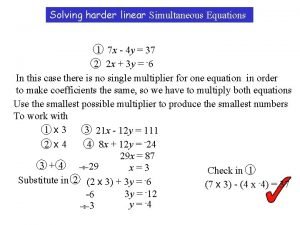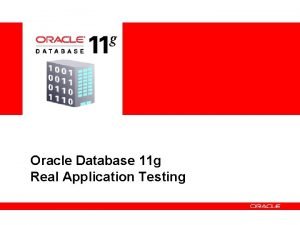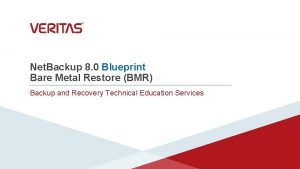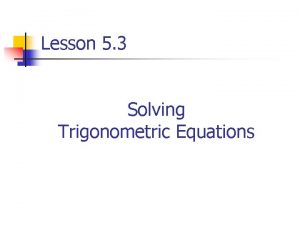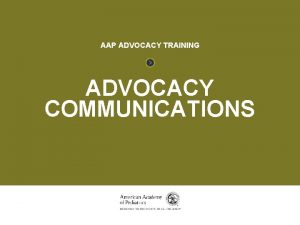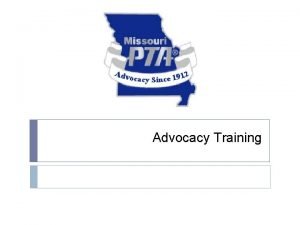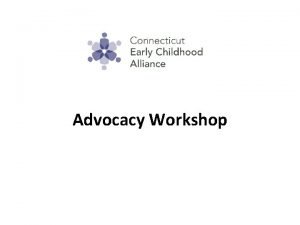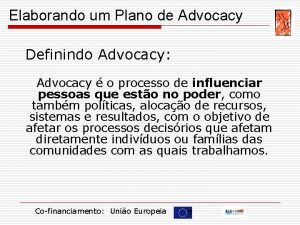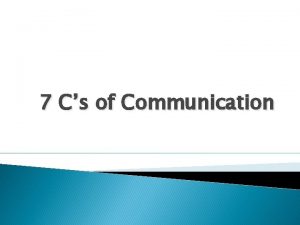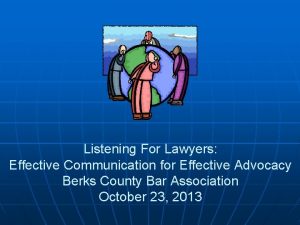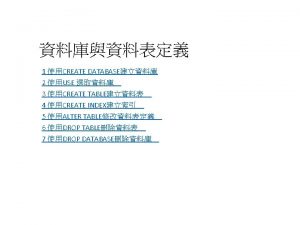Create Effective Advocacy Communication Step Effective Advocacy Communication


















- Slides: 18

Create Effective Advocacy Communication

Step Effective. Advocacy. Communication Step 5: 5: Create Effective Communication • Effective communication translates the issue into a concise and compelling case for a target audience • A process that takes the target audience’s knowledge, interests, and skills into account Inform Persuade Move to Action Advocacy Communication Model Source: A 2 Analysis and Advocacy, Advocacy Training Manual. Health Policy Initiative; 2007.

What is Advocacy Communication? Any planned communication activity that seeks to achieve one of the following communication goals: • Inform • Persuade • Move to action Inform Persuade Move to Action Advocacy Communication Model Source: A 2 Analysis and Advocacy, Advocacy Training Manual, Health Policy Initiative; 2007.

Considerations for Delivering an Advocacy Message Stage Determination Content/Ideas Messenger/Source Language Format/Medium Time/Place Source: A 2 Analysis and Advocacy, Advocacy Training Manual, Health Policy Initiative; 2007.

Stage. Determination Stage Inform Persuade Move to Action • Use the data in the target audience analysis to determine the stage. • Collect additional information, as needed, to determine the stage.

Content/Ideas A message must answer the questions: • What is the issue? • Why should the target audience care? • What is the solution and the impact on the problem? • What specifically should the target audience do?

Messenger/Source • Messenger: the person delivering your advocacy message or communication • The ideal messenger should: – Represent the appropriate level of seniority – Be credible with the audience – Be an effective communicator – Support your advocacy goal – Have influence with your audience

Other Considerations Language Format/Medium Time/Place Complexity and technical depth of the language Multiple methods to communicate a message—refer to the audience analysis Linked to other activities or significant locations/dates

Format/Medium Examples Website Rally Technical Brief and Meeting Walkout Press Conferenc e

Activity—Developing Advocacy Messages What is the issue? Why should the target audience care? Components of an Advocacy Message What is the solution and its impact on the problem? What specifically should the target audience do?

Characteristics of Effective Communication • Simple • Focused • Concise/brief • Solution-oriented • Supported by evidence • Addresses a key interest of the target audience • Appropriate language • Has a clear request Adapted from: Stronger Health Advocates, Greater Health Impacts (PATH), 2013.

Questions?

A One-Minute Message What is the issue? Why should the target audience care? Components of an Advocacy Message What is the solution and its impact? What should the target audience do? Adapted from: A 2 Analysis and Advocacy, Advocacy Training Manual, Health Policy Initiative; 2007.

What makes a speech compelling • • Includes a “hook” Shares data in a relatable way Humanizes the pitch Contains a “call to action”

Identify the missing component in the example below: Members of key populations are unlikely to go for HIV testing because of stigma, discrimination, lack of confidentiality, coercion, and fear of repercussions, in addition to a lack of appropriate health services, resources, and supplies. However, because HIV incidence and prevalence are higher in key populations, it is important that key population members get tested and then linked to care if they are HIV positive. UNAIDS recommends that HIV testing services be available in locations and settings acceptable and convenient to members of key populations, including community-based services. However in ABC land, Policy 123 issued by the Ministry of Health only permits testing by trained nurse practitioners at regional facilities. During a visit to XYZ region, Sue, a sex worker, told me she’d like to go for HIV testing, but given her work hours and the stigma she feels when she travels to the regional clinic, which is two hours away, she doesn’t think she’ll go in for testing.

Activity—Develop a One-Minute Message Using your current examples, develop a one-minute message (40 minutes): • Use the worksheets from the previous activities • Use the target audience from the previous activity • Decide the context – Time/place – Who is delivering the message • Role play delivery of the message Adapted from: A 2 Analysis and Advocacy, Advocacy Training Manual, Health Policy Initiative; 2007.

Points to Remember • Content—What information does the target audience need? What stage of the model are they in? • Language—use audience-appropriate language, know their interests, situation, and vocabulary • Select a credible messenger • Choose a format/medium that enhances your message • Pick a strategic time/place for message delivery

Learning Objectives—Session 9 • Identify the steps to develop and deliver an effective advocacy message • Develop an advocacy message based on your draft strategy • Deliver and provide feedback on a one-minute message
 Step 1 step 2 step 3 step 4
Step 1 step 2 step 3 step 4 Apa itu mutiple queue dan one way list
Apa itu mutiple queue dan one way list Advocacy communication and social mobilization
Advocacy communication and social mobilization Buccal pit molar
Buccal pit molar The age of the dinosaurs text structure
The age of the dinosaurs text structure How to write an informative essay step by step
How to write an informative essay step by step Persuasive essay sentence starters
Persuasive essay sentence starters Step up step back
Step up step back One solution quadratic equation
One solution quadratic equation Linear simultaneous equations
Linear simultaneous equations Simultaneous equations step by step
Simultaneous equations step by step Simplifying and solving equations
Simplifying and solving equations The steps of photosynthesis
The steps of photosynthesis Particle filter example step by step
Particle filter example step by step Real application testing
Real application testing Veritas bare metal restore
Veritas bare metal restore Sine equations
Sine equations Sophia loren face shape
Sophia loren face shape How to draw a punnett square
How to draw a punnett square


